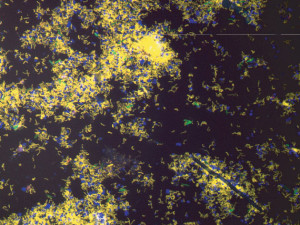A tool to help microbial ecologists link phages to hosts in ecological studies.
The Science:
Using metagenomic datasets produced from the Iron Mountain site in Northern California and customized tools, researchers used bacterial spacer sequences commonly called CRISPRs to link phage and hosts in ecological studies.

Sampling pink biofilms growing in acid mine drainage deep underground in the Richmond Mine, Iron Mountain, Calif. (Photo by Paul Wilmes)
The Impact:
Interactions between uncultivated microbes and their phage influence the local ecosystem as well as each other. CRISPR sequences can help researchers link phage and hosts in metagenome datasets, and analyze their interactions over time.
Summary
The interactions between microbes and their phage influence their ecosystems. However, identifying phage and linking them to their hosts is a challenge researchers face in conducting ecological studies. As microbes play crucial roles in geochemical cycles and environmental processes, learning more about their diversity and understanding their activities is a major goal of the U.S. Department of Energy (DOE).

Probes targeting bacteria (EUBmix; fluorescein isothiocyanate (green)) and archaea (ARC915; Cy5 (blue)) were used in combination with a probe targeting the Leptospirillum genus (LF655; Cy3 (red)). Overlap of red and green (yellow) indicates Leptospirillum cells and shows the dominance of Leptospirillum. (Banfield Lab, UC Berkeley)
One method employed by University of California, Berkeley microbial ecologist Jill Banfield and her team involves looking at Clustered Regularly Interspaced Short Palindromic Repeats (CRISPR) loci, a microbial immune system that is known to protect bacteria from virus infection. Banfield’s team can look for CRISPR spacer sequences in host microbes and link them back to the infective phages, as well as distinguish ancient from more recent encounters based on positioning within the locus. In a study published ahead September 22, 2015 in The ISME Journal, Banfield and her team evaluated their ability to look at the genetic diversity and population histories of microbial communities using sequence datasets developed in collaboration with the DOE Joint Genome Institute (JGI), a DOE Office of Science user facility.
In the study, Banfield’s team relied on metagenomic datasets collected over five years from nine biofilms at the Richmond Mine, Iron Mountain site, a project that marks the earliest collaboration between Banfield and the DOE JGI, as well as amplified CRISPR region sequences from similar samples.
The team developed tools to analyze the CRISPR sequences in the datasets, including a custom script that extracts the CRISPR sequences from the metagenome sequencing reads. Specifically, they were able to identify spacers from Leptospirillum bacteria in the datasets and examine the spectrum of phage the bacteria had encountered over time. They also found 2 different CRISPR systems in the metagenomic datasets. “The results show that population-level analyses of CRISPR loci can provide insight into phage-host interaction dynamics and the recent history of bacteria in natural systems,” the team reported.
Contact
Susannah Tringe
User Programs Deputy
DOE Joint Genome Institute
sgtringe@lbl.gov
Funding
- U.S. Department of Energy Office of Science
- Army Research Office
Publication
Sun CL et al. Metagenomic reconstructions of bacterial CRISPR loci constrain population histories. ISME J. 2015 Sep 22. doi: 10.1038/ismej.2015.162. [Epub ahead of print]